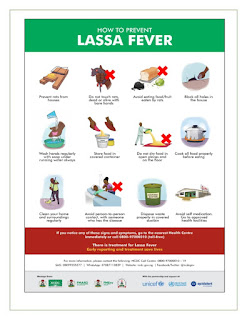Epidemiological data show that Lassa fever occurs throughout the year, but more cases are recorded during the dry season i.e. November through May.
This is an advisory to health care workers, to prevent person to person transmission of Lassa fever especially in health care settings.
Lassa fever is spread through:
- Direct contact with urine, faeces, saliva or blood of infected rodents.
- Ingesting food and drinks contaminated with urine, faeces, saliva or blood of infected rats.
- Contact with objects, household items or surfaces contaminated with urine, faeces, saliva or blood of infected rats.
- Person-to-person transmission can also occur through contact with blood, urine, faeces, vomitus and other body fluids of an infected person, particularly in hospital environment where infection prevention and control practices are not optimal.
 |
| How to prevent Lassa Fever |
Signs and symptoms of Lassa fever:
The early stages of Lassa fever present initially like other febrile illness such as malaria. Symptoms of the disease generally include fever, headache, sore throat, general body weakness, cough, nausea, vomiting, diarrhoea, muscle pains, chest pain, and in severe cases; unexplainable bleeding from ears, eyes, nose, mouth, vagina, anus and other body orifices. It could also present as persistent bleeding from sites of intravenous cannulation.
The incubation period (time between an infection and appearance of symptoms of the disease) is 3 to 21 days. Early diagnosis and treatment increase the chances of survival.
Inappropriate use of personal protective equipment (PPE) such as gloves, masks and poor IPC practices, increase the risk of person to person transmission of Lassa fever.
Other risk factors that can lead to health care worker infection include:
- Doctors, nurses and other health workers providing direct patient care without standard precautions.
- Hospital support staff cleaning or disinfecting contaminated surfaces, materials and supplies without adequate protective gear.
- Laboratory staff handling blood samples of patients without appropriate precautions.
- Medical or hospital support staff preparing and/or handling dead bodies of Lassa fever patients without appropriate precautions.
To reduce the risk of Lassa fever, the Nigeria Centre for Disease Control (NCDC) offers the following advice to all health care workers:
- Practice standard precautions at all times while handling patients and body fluids i.e. always perform hand hygiene at the designated five moments, wear the correct PPE based on the procedure to be performed, irrespective of provisional diagnosis of the patient.
- Appropriately dispose and disinfect items used by Lassa fever patients such as syringes, thermometers, beddings, clothing, cups, plates, spoons, etc. Ensure injectables and sharp items are disposed safely.
- Clean the hospital environment regularly using appropriate materials and methods.
- Dispose of all healthcare waste in a safe manner.
- Maintain a high index of suspicion for Lassa fever i.e. be vigilant and look out for Lassa fever symptoms. Remember, not all fevers are due to malaria.
- Test all suspected cases of malaria using Rapid Diagnostic Test (RDT). When the RDT is negative, other causes of febrile illness including Lassa fever should be considered and cases investigated accordingly.
Any febrile illness that has not responded to 48 hours use of anti-malaria or antibiotics should raise an index of suspicion for Lassa fever!
The national guidelines for Lassa fever case management and Infection prevention and control are available on the NCDC website for download (http://ncdc.gov.ng/diseases/guidelines).
Please report all suspected cases of Lassa fever to your Local Government Area Disease Surveillance and Notification Officer (DSNO). They are the first link to response and care for Lassa fever cases in Nigeria.
Contact:
NCDC Toll-Free Number: 0800-970000-10
SMS: 08099555577
Whatsapp: 07087110839
Twitter/Facebook: @NCDCgov






